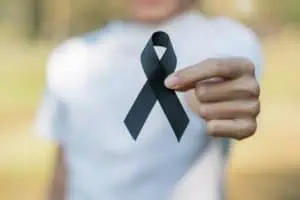
Medical Review By: Dr. Ted Schiff
Anyone who’s had breast cancer or skin cancer should know the unfortunate truth: Having one of these diseases seems to increase the likelihood of developing the other.
The risk for getting hit with this double whammy appears to be highest among younger women. And unfortunately, the form of skin cancer most closely associated with breast cancer also happens to be the most dangerous, melanoma.
Here’s a summary of what the science says.
Young breast cancer survivors at increased melanoma risk
A 2004 study looked at a large database of health records for women in nine regions of the United States. Breast cancer survivors age 50 and younger had a 46% increased risk for later being diagnosed with melanoma. Women who’d had melanoma were more likely than others to develop breast cancer, though the increase in risk was much lower.
In a 2011 study, female breast cancer survivors under age 45 had a 38% increased risk for developing melanoma compared to the general population. Among women over 45 who survived breast cancer, the increased risk for melanoma was 12%.
A weaker link between other skin cancers and breast cancer
Any association between breast cancer and non-melanoma forms of skin cancer, which include basal cell and squamous cell cancers, is less clear. Study have yielded mixed results.
A 2013 study found that women (average age 66) who’d had non-melanoma skin cancer had a 19% increased risk for eventually being diagnosed with breast cancer. A study of more than 70,000 postmenopausal women published the same year found no link between non-melanoma skin cancers and breast cancer — but it discovered that women with a history of basal cell or squamous cell cancer who developed breast cancer were more likely to have an advanced case of breast cancer.
Are BRCA genes a double threat?
If your mom or sister had both breast cancer and skin cancer, does that mean a similar fate may await you? Research offers clues that a risk for both conditions could be inherited in your genes, though whether that’s true remains unclear.
Genes called BRCA1 and BRCA2 increase the risk for breast cancer. Some research has linked them, especially BRCA2, to melanoma, too. But the authors of a 2021 scientific review of the current evidence called that association “relatively weak” and argued that neither gene is likely to have much influence over whether or not a person develops melanoma.
What you can do
Researchers still have a lot to learn about the link between breast cancer and skin cancer, but early diagnosis of either disease is critical no matter what, as are skin cancer prevention measures.
Mammograms
Most women should consider having annual mammograms when they turn 40, according to the American Cancer Society, and make mammograms a yearly event at age 45 (then consider reducing the frequency at age 55). Women who have a family history of breast cancer or who know they carry genetic mutations such as the BRCA gene that increase their risk should begin screening earlier.
The benefits of having a doctor physically examine your breasts, or examining your own breasts regularly, has recently come into question, but the American Cancer Society suggests at least being familiar with your breasts and reporting any changes to a doctor.
Skin checks and self-exams
Frequent skin self-exams, on the other hand, are essential. Your dermatologist can advise on how often to perform them, though monthly is a common rule of thumb. The American Cancer Society has a guide on how to do a skin self-exam.
Most people should also have an annual full-body skin exam at their dermatologist’s office.
Sun protection
Everyone should protect their skin from the damaging effects of the sun, but double down on those efforts if you’re a breast cancer survivor or if you’re undergoing treatment for breast cancer or any other malignancy. Chemotherapy may make skin more vulnerable to the harms of UV rays, and radiation may have already caused skin redness or burns.
You know the rules: Use a broad-spectrum sunscreen with an SPF of 30 or higher on any day that you’ll be outside, and cover up with protective clothing.
Article Written By: Timothy Gower, an award-winning journalist who writes about medicine and health. His work has appeared in more than two dozen national magazines.





